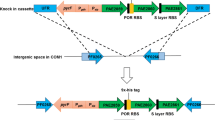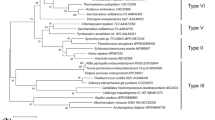Abstract
Adenosine 5′-phosphosulfate (APS) reductase is a key enzyme involved in the pathways of sulfate reduction and sulfide oxidation in the biological sulfur cycle. In this study, the gene of APS reductase from Acidithiobacillus ferrooxidans was cloned and expressed in Escherichia coli, the soluble protein was purified by one-step affinity chromatography to apparent homogeneity. The molecular mass of the recombinant APS reductase was determined to be 28 kDa using SDS-PAGE. According to optical and EPR spectra results of the recombinant protein confirmed that the iron–sulfur cluster inserted into the active site of the protein. Site-directed mutation for the enzyme revealed that Cys110, Cys111, Cys193, and Cys196 were in ligation with the iron–sulfur cluster. The [Fe4S4] cluster could be assembled in vitro, and exhibited electron transport and redox catalysis properties. As we know so far, this is the first report of expression in E. coli of APS reductase from A. ferrooxidans.








Similar content being viewed by others
References
Rawlings DE (2001) The molecular genetics of Thiobacillus ferrooxidans and other mesophilic, acidophilic, chemolithotrophic, iron- or sulfur-oxidizing bacteria. Hydrometallurgy 59:187–201
Valdés J, Veloso F, Eugenia J, Holmes D (2003) Metabolic reconstruction of sulfur assimilation in the extremophile Acidithiobacillus ferrooxidans based on genome analysis. BMC Genom 51:1471–2164
Bick JA, Dennis JJ, Zylstra GJ, Nowack J, Leustek T (2000) Identification of a new class of 59-adenylylsulfate (APS) reductases from sulfate-assimilating bacteria. J Bacteriol 182:135–142
Kopriva S, Buchert T, Fritz G et al (2002) The presence of an iron–sulfur cluster in adenosine 5′-phosphosulfate reductase separates organisms utilizing adenosine 5′-phosphosulfate and phosphoadenosine 5′-phosphosulfate for sulfate assimilation. J Biol Chem 277:21786–21791
Setya A, Murillo M, Leustek T (1996) Sulfate reduction in higher plants: molecular evidence for a novel 5′-adenylylsulfate reductase. Proc Natl Acad Sci U S A 93:13383–13388
Carroll KS, Gao H, Chen H et al (2005) Investigation of the iron–sulfur cluster in Mycobacterium tuberculosis APS reductase: implications for substrate binding and catalysis. Biochemistry 44:14647–14657
Kelley BC, Tuovinen OH, Donald Nicholasen DJ (1976) Utilization of 35S-thiosulphate and an appraisal of the role of ATP-sulphurylase in chemolithotrophic Thiobacillus ferrooxidans. Arch Microbiol 109:205–208
Sodeoka M, Larson C, Chen L, Land W, Verdine G (1993) A multifunctional plasmid for protein expression by ECPCR: overproduction of the p50 subunit of NF-κB. Bioorg Med Chem Lett 3:1095–1100
Bradford MM (1976) A rapid and sensitive method for the quantitation of microgram quantities of protein utilizing the principle of protein-dye binding. Anal Biochem 72:248–254
Laemmli U (1970) Cleavage of structural proteins during the assembly of the head of bacteriophage T4. Nature 227:680–685
Trüper HG, Lynne AR (1971) Purification and properties of adenylyl sulfate reductase from the phototrophic sulfur bacterium, Thiocapsa roseopersicina. J Bacteriol 108:1112–1121
Fritz G, Büchert T, Kroneck PM (2002) The function of the [4Fe4S] clusters and FAD in bacterial and archaeal adenylysulfate reductases. J Biol Chem 277:26066–26073
Kim SK, Rahman A, Bick JA et al (2004) Properties of the cysteine residues and iron–sulfur cluster of the assimilatory 5′-adenylyl sulfate reductase from Pseudomonas aeruginosa. Biochemistry 43:13478–13486
Kim SK, Rahman A, Mason JT et al (2005) The interaction of 5′-adenylylsulfate reductase from Pseudomonas aeruginosa with its substrates. Biochim Biophys Acta 1710(2–3):103–112
Acknowledgments
This work was supported by the National Basic Research Program of People’s Republic of China (2004CB619204) and National Natural Science Foundation of People’s Republic of China (50321402) and FANEDD (200549).
Author information
Authors and Affiliations
Corresponding author
Rights and permissions
About this article
Cite this article
Zheng, C., Zhang, Y., Liu, Y. et al. Characterization and Reconstitute of a [Fe4S4] Adenosine 5′-Phosphosulfate Reductase from Acidithiobacillus ferrooxidans . Curr Microbiol 58, 586–592 (2009). https://doi.org/10.1007/s00284-009-9375-1
Received:
Revised:
Accepted:
Published:
Issue Date:
DOI: https://doi.org/10.1007/s00284-009-9375-1




